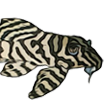/siluriformes/doradidae/agamyxis/pectinifrons/1.jpg)
Spotted Talking Catfish, Kammdornwels (Germany), Plettet Tornmalle (Denmark), Spotted Raphael Catfish - Agamyxis pectinifrons (Cope, 1870)
Article © Julian Dignall, uploaded April 01, 1997.
This is another fish that can destroy a good net when attempting to transfer them. Although it can be a bit painful, it is possible to move this fish by hand. This is best practiced with small fish and rubber gloves initially, but seasoned pros can literally pluck these fish from underneath a rock. You must get a finger between each pectoral fin and the catfishes body with your thumb above the head. Due to a reflex driven defensive mechanism the fish will lock its pectoral fins, trapping your fingers! I recall reading that this action is used by the fish when caught to make itself as difficult to swallow as possible. The fish will remain locked to your fingers until you transfer it and submerge it once again when it will release and dart off to the nearest dark refuge.
Whether you transfer the fish by this or more conventional methods you will probably hear why it is called a talking catfish during the transfer. The fish emits a high pitched croaking noise which can be surprisingly loud. The fish achieves this by grinding the base of its pectoral fin bone against its shoulder bone; much like the noise you can make by grinding your teeth, but louder! Most, if not all, of the 80 - 100 members of the family can "talk" in this manner. Amongst these are some true giants (4ft +) which I would very much like to hear.
Copyright information for the images used in this article can be found on the species' full Cat-eLog page.
| Scientific Name | Agamyxis pectinifrons (Cope, 1870) |
| Common Names | Spotted Talking Catfish Kammdornwels (Germany), Plettet Tornmalle (Denmark), Spotted Raphael Catfish |
| Type Locality | Pebas, Peru. |
| Synonym(s) | Doras flavopictus, Doras pectinifrons |
| Pronunciation | peck TIN ee frons |
| Etymology | Agamyxis: From the Greek agan, meaning much, and myxa, meaning mucus; in reference to the mucus produced by the fish. |
| Articles | |
| Size | 150mm or 5.9" SL. Find near, nearer or same sized spp. |
| Identification | The light coloured spots that make this fish so attractive range from brilliant white to pale yellow in different batches of imports. |
| Sexing | Unknown. |
| Distribution | South America: Amazon River basin. Amazon (click on these areas to find other species found there) Login to view the map. |
| IUCN Red List Category | Least Concern , range map and more is available on the IUCN species page. Last assessed 2020. |
| pH | 6.0 - 7.5 |
| Temperature | 20.0-26.0°C or 68-78.8°F (Show species within this range) |
| Feeding | Will eat any food that reaches it. Bloodworm and sinking catfish tablets are best as they can be ''aimed'' at the fishes daytime hide-out. User data. |
| Furniture | Needs a dark refuge, but smaller individuals will spend the day in dense vegetation just as happily. |
| Compatibility | A perfect community fish |
| Suggested Tankmates | Ideal first catfish for a budding aquarist as well as a good "worker" catfish for all levels of community tanks |
| Breeding | Some details, although sketchy. Seems to be a bubble nest builder or at least lay its eggs on floating vegetation at the water surface. |
| Breeding Reports | There is no breeding report. |
| Reference | Proceedings of the American Philosophical Society v. 11, pp 568. |
| Registered Keepers | There are 232 registered keepers, view all "my cats" data. |
| Wishlists | Love this species? Click the heart to add it to your wish list. There are 10 wishes to keep this species, see who wants what. |
| Spotters | Spotted this species somewhere? Click the binoculars! There are 47 records of this fish being seen, view them all. |
| Forum BBCode | |
| Search for A. pectinifrons | |
| Look up A. pectinifrons on AquaticRepublic.com | |
 | Look up A. pectinifrons on Fishbase |
 | Look up A. pectinifrons on Encyclopedia of Life |
 | Look up A. pectinifrons on Global Biodiversity Information Facility |
| LFS label creator ARN ref:1.12.109.313 | |
| Last Update | 2020 Sep 19 01:53 (species record created: 1997 Apr 01 11:22) |
Back to Catfish of the Month index.




